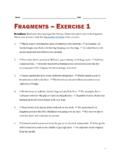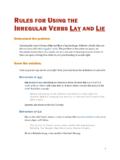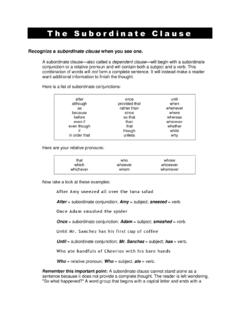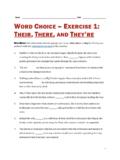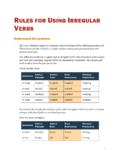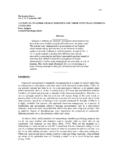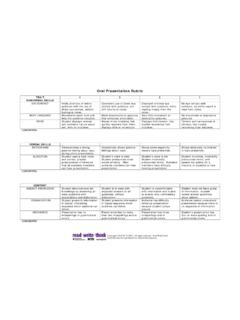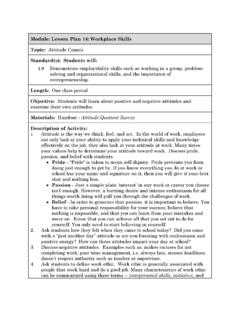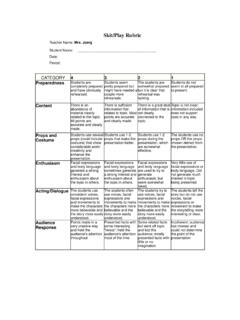Transcription of The Clause
1 1 THE Clause Recognize a Clause when you see one. clauses come in four types: main [or independent], subordinate [or dependent], relative [or adjective], and noun. Every Clause has at least a subject and a verb. Other characteristics will help you distinguish one type of Clause from another. MA I N CL A U S E S Every main Clause will follow this pattern: SU B J E C T + VERB = C o m p l e t e T h o u g h t. Here are some examples: Lazy students whine. Students = subject; whine = verb. Cola spilled o ver the glass and splashed onto the counter. Cola = subject; spilled, splashed = verbs. My dog loves pizza c rusts. Dog = subject; loves = verb. The important point to remember is that every sentence must have at least one main Clause . Otherwise, you have a fragment, a major error.
2 SU B O R D I N A T E CL A U S E S A subordinate Clause will follow this pattern: S u b o r d i n a t e C o n j u n c t i o n + S u b j e c t + V e r b = I n c o m p l e t e T h o u g h t. Here are some examples: 2 Whenever lazy students whine Whenever = subordinate conjunction; students = subject; whine = verb. As cola spilled ove r the glass and splashed onto the counter As = subordinate conjunction; cola = subject; spilled, splashed = verbs. Because my dog loves pizza crusts Because = subordinate conjunction; dog = subject; loves = verb. The important point to remember about subordinate clauses is that they can never stand alone as complete sentences. To complete the thought, you must attach each subordinate Clause to a main Clause . Generally, the punctuation looks like this: M a i n C l a u s e + + S u b o r d i n a t e C l a u s e.
3 S u b o r d i n a t e C l a u s e + , + M a i n C l a u s e. Check out these revisions to the subordinate clauses above: Wheneve r lazy stude nts whine, Mrs. Russell throws chalk erasers at their heads. Anthony ran for the pa per towe ls as cola spille d over the glass and splashe d o nto the counter. Becau se my do g love s pizza cru sts, he never barks at the delive rym an. RE L A T I V E CL A U S E S A relative Clause will begin with a relative pronoun [such as who, whom, whose, which, or that] or a relative adverb [when, where, or why]. The patterns look like these: R e l a t i v e P r o n o u n or A d v e r b + S u b j e c t + V e r b = I n c o m p l e t e T h o u g h t. R e l a t i v e P r o n o u n as S u b j e c t + V e r b = I n c o m p l e t e T h o u g h t.
4 3 Here are some examples: Whom Mrs. Russell hit in the head with a chalk eraser Whom = relative pronoun; Mrs. Russell = subject; hit = verb. Where he chews and drools with great en thusiasm Where = relative adverb; he = subject; chews, drools = verbs. That had spilled over the glass and splashed onto the counter That = relative pronoun; had spilled, splashed = verbs. Who loves pizza c rusts Who = relative pronoun; loves = verb. Like subordinate clauses , relative clauses cannot stand alone as complete sentences. You must connect them to main clauses to finish the thought. Look at these revisions of the relative clauses above: The lazy students whom Mrs. Ru sse ll hit in the head with a chalk erase r soon learned to keep their complaints to the mselves.
5 My dog Floyd, who love s pizza crusts, eats them under the kitchen table, whe re he chews and drools with great enthusiasm. Anthony ran to get paper towels for the cola that had spilled ove r the glass and splashed o nto the cou nter. Punctuating relative clauses can be tricky. You must decide if the relative Clause is essential or nonessential and then use commas accordingly. Essential relative clauses do not require commas. A relative Clause is essential when you need the information it provides. Look at this example: A dog that eats too much pizza will soon develop peppe roni breath. Dog is nonspecific. To know which dog we are talking about, we must have the information in the relative Clause . Thus, the relative Clause is essential and requires no commas.
6 4 Grammar Bytes! | | 2018 If, however, we revise dog and choose more specific words instead, the relative Clause becomes nonessential and does require commas to separate it from the rest of the sentence. Read this revision: My dog Floyd, who eats too much pizza, has developed pepperoni breath. NO U N CL A U S E S Any Clause that functions as a noun becomes a noun Clause . Look at this example: You really do not wan t to know the ingredients in Aunt Nancy's ste w. Ingredients = noun. If we replace the noun ingredients with a Clause , we have a noun Clause : You really do not wan t to know what Au nt Nanc y adds to her stew. What Aunt Nancy adds to her stew = noun Clause .
